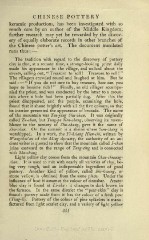Page 437 - Oriental Series Japan and China, Brinkly
P. 437
CHINESE POTTERY
keramic productions, has been investigated with so
much care by an author of the Middle Kingdom,
further research may yet be rewarded by the discov-
ery of equally elaborate records in other branches of
the Chinese potter's art. The document translated
runs thus :
The tradition with regard to the discovery of pottery
clay is that, at a remote time, a strange-looking priest daily
made his appearance in the village, and walked about the
Treasure to sell !
" "
Treasure to sell !
streets, calling out,
The villagers crowded round and laughed at him. But he
said : "If you do not care to buy treasure, how can you
"
hope to become rich ? Finally, an old villager accompa-
nied the priest, and was conducted by the latter to a moun-
tain where a hole had been partially dug. After this the
priest disappeared, and the people, examining the hole,
found that it shone brightly with all the five colours, so that
its interior presented the appearance of brocade. The name
of the mountain was Tao-jung Shu-shan. It was originally
called Tu-shan, but Tung-po Sien-shang^ observing its resem-
blance to the scenery of Shu-chung^ gave it the name of
Shu-shan. On the summit is a shrine where Sien-shang is
worshipped. In a work, the Yi-hsiang Hien-chi, written by
Wangchw* an of the Ming dynasty, the authority of an an-
cient writer is quoted to show that the mountain called I-shan
joins eastward to the range of Tung-ting and is connected
with Shu-shang
Light yellow clay comes from the mountain Chao-chwang-
shan. It is used to mix with nearly all varieties of clay, be-
ing very tough, and an indispensable ingredient of good
pottery. Another kind of yellow, called Shi-hwangy or
stone yellow, is obtained from the same place. Under the
influence of heat it assumes the colour of cinnabar. Azure-
blue clay is found at sLaim-eshduis:triitctchtahnege"spteoard-asrkiknb"rocwlnay in
the furnace. In the
is
found : pottery made from it has the colour of a fresh pear
(Tung-li}. Pottery of the colour of pine spikelets is manu-
factured from light scarlet clay, and a variety of light yellow
355

